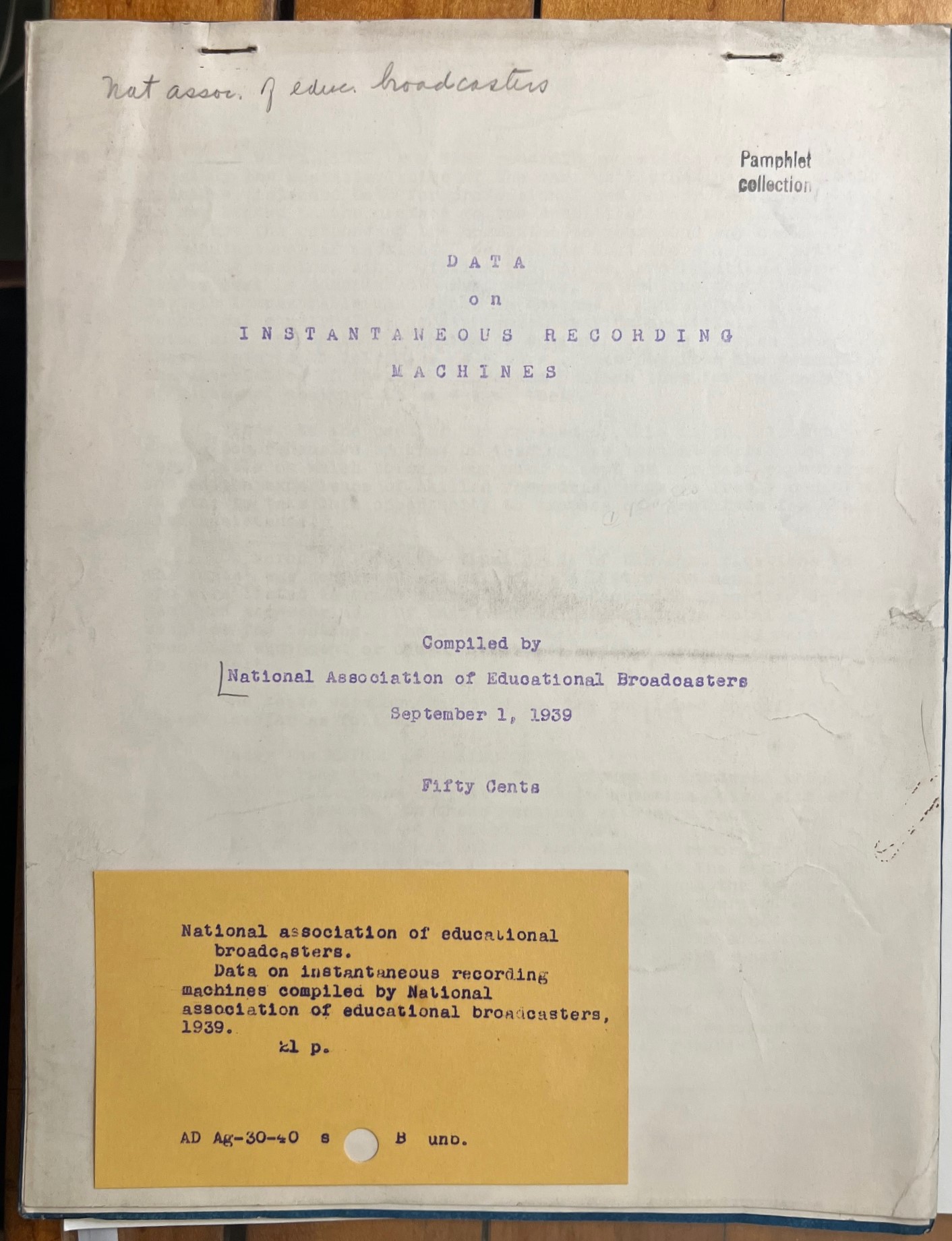
National Association of Educational Broadcasters. **NO Copies listed in WorldCat**
(Audio Recording) Data on Instantaneous Recording Machines
National Association of Educational Broadcasters: 1939
- $200
(Audio Recording) Data on Instantaneous Recording Machines compiled by the National Association of Educational Broadcasters, September 1, 1939. 11"x8.5" 21 leaves with 4 plates of blueprinted graphs of frequency response curves and etc. Stapled at top. Printing seems to be mimeograph. Provenance" Library of Congress, with their small "Pamphlet Collection" stamp at top right corner and surplus rubber stamp on rear page. VG copy. Interesting document reviewing the state-of-the-art auto recording devices at a still-young period of this technology. [++] No copies found in WorldCat.[++] Comes with a nice piece of LC ephemera--a carbond copy of the LC card catalaog crd (or one of them, at least)
More from JF Ptak Science Books
Mémoire sur les Combinaisons du Phosphore, et particulièrement sur celles de ce corps avec l’hydrogène” in “Annales de Chimie et de Physique.”
Dumas, Jean Baptiste André. "Mémoire sur les Combinaisons du Phosphore, et particulièrement sur celles de ce corps avec l'hydrogène" in "Annales de Chimie et de Physique, Par MM. Gay-Lussac et Arago," Paris, Crochard, 1826 (February), volume 31, 113-223, folding plate, with the Dumas on pp113-153. Original wrappers. Nice copy. VG condition. 135.00 [++] "Dumas was one of the leading chemists in France in the mid-19th century. He is best known for the Dumas method of determining atomic and molecular weights and for determining the atomic weights of thirty chemical elements. Eventually his method was superseded by other techniques, including mass spectroscopy. Dumas is also known for the Dumas method of determining the amount of nitrogen in chemical substances. This method is still widely used, especially to determine the protein content of foods, because it is relatively fast and easy to use and fully automatable."--Society of Catholic Scientists. [++]"Jean Baptiste André Dumas (1800-1884) was a French chemist, best known for his works on organic analysis and synthesis, as well as the determination of atomic weights and molecular weights by measuring vapor densities. He also developed a method for the analysis of nitrogen in compounds."-_Wikipedia "In 1826 he devised a method of measuring vapour density. He went on to discover various organic compounds, including anthracene (1832), urethane (1833), and methanol (1834), which led him in 1840 to propose the theory of types (functional groups)."--ibid. Additionally "He was a masterful teacher, serving as mentor to many important French chemists, including Auguste Laurent, Charles-Adolphe Wurtz, and Louis Pasteur"--Britannica See: Jane Woodward, "Jean Baptiste André Dumas" Journal of Chemical Education 1951 28 (12), 630.Digital Computer Primer.
E.M. McCormick. E.M. McCormick. Digital Computer Primer. McGraw-Hill, 1959. Nice copy in a dustjacket EXCEPT there is some sort of dampstaining along the top of the textblock. Not a bad copy, really kinda of nice, in cloth, with a dustjacket. I'd just like to move this along hence the low price. Cheaper than a paperback reprint of this classic!- $15
- $15
5 items including three offprints and two mimeographed (or carbon paper?) papers.
Dr.-Ing. G. SACHS, Mitarbeiter im Kaiser-Wilhelm-Institut für Metallforschung, Privatdozent an der Technischen Hochschule Berlin, und Dipl.-Ing. Dr.-Ing. G. SACHS, Mitarbeiter im Kaiser-Wilhelm-Institut für Metallforschung, Privatdozent an der Technischen Hochschule Berlin, und Dipl.-Ing. 5 items including three offprints and two mimeographed (or carbon paper?) papers. (1) "Zur Abeitung einer Fliessbedingung. 13"x8.25", 9 sheets. 1929. Mimeo (or carbons?) Numerous equations written in by hand. (2) "Elastische Eigenschaften von Messingkristallen" ca. 1930. 13"x8.25", 6 leaves, several manuscript annotations. With manuscript graph attached by paper clip. (3) "Versuche uber die Reibung fester Korper" offprint from Z. fur Angewandte Math. u. Mechanik, 1924, 1/32, 31pp. Tall *8vo, with lengthy presentation signed by the author. Staple bound. Good condition. (4) "Einfluss der Probenhohe auf den Stauchversuch" 1924. Offprint. Uncertain of source. 4pp. Signed vom Verfasser etc. Good condition. (5) "Beitrag zum Harteproblem" offprint from "Zeit. Fur technische physik",vol 4, 1927, pp 131-142. Signed from the author to Prof. Hans Reissner. Good.- $200
- $200
MANDELBROT, Benoit. “An Informational Theory of the Statistical Structure of Language” (including Zipf’s law). And: Bar-Hillel and Carnap, “Semantic Information”; MacKay, “Generators of Information” and numerous others.
MANDELBROT, Benoit. AND Bar-Hillel, Carnap, MacKay, and many others. MANDELBROT, Benoit. "An Informational Theory of the Statistical Structure of Language" (including Zipf's law) in Communication Theory, papers read at a Symposium on Applications of Communication Theory" New York, Academic Press, 1953.532pp. Nice solid copy. VG copy. Includes: Bar-Hillel and Carnap, "Semantic Information" pp 503-512; MacKay, "Generators of Information" pp 475-484, and numerous others. Cloth binding.- $50
- $50
Grundzüge der Theoretischen Logik.
HILBERT, D. & W. ACKERMANN. HILBERT, D. & W. ACKERMANN. Grundzüge der Theoretischen Logik. Berlin: Julius Springer, 1938. viii, 133pp. Very Good. Original wrappers. Few bumps and very short tears here and there. Die Grundlehren der Mathematischen Wissenshaften in Einzeldarstellungen, Band XXVII. This is a nice copy of a great classic in the history of mathematical logic.(Audio Recording) Data on Instantaneous Recording Machines: https://rarebookinsider.com/rare-books/audio-recording-data-on-instantaneous-recording-machines/